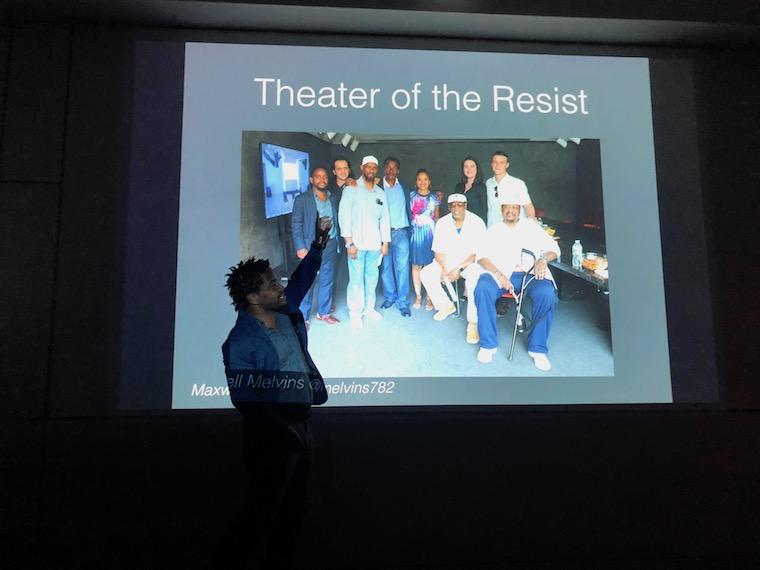Studio Art: Pathways From Classroom to Career
September 27, 2018
Erin Ulrich ’18

The Pathways: Studio Art series brings current students face-to-face with alumni, helping them visualize a career with a BA in art.
As national university enrollment rates have dropped steadily year by year, the Studio Art program at Oberlin has grown exponentially. Professor of Studio Art Nanette Yannuzzi says that the program has increased from between 12 to 15 senior majors graduating each year when it was established more than 20 years ago, to 29 graduating seniors in 2018.
The series evidences the myriad ways Oberlin studio art graduates have found careers and dispels myths that students who study art have limited career options.
Pathways has a clear focus: How do I turn this thing I love studying into something sustainable long-term? Yannuzzi co-teaches Senior Studio and Thesis in studio art and has been instrumental in seeing the series through as well as ensuring that the program prepares students for life after graduating.
When the studio art program at Oberlin began, professors would take their graduating seniors to New York City for professional development activities presented by the New York Foundation for the Arts.
Because of the program’s expansion, it no longer has the ability to fund trips to New York for 30-plus students. But Yannuzzi and her colleagues are building professional development initiatives in Oberlin by tapping into the program’s robust and intimate alumni network.
Pathways is a continuation of the career-focused requirements that all studio art majors must complete. It includes applying for one professional postgrad opportunity. Past students have had success and even launched their careers because of this requirement, such as Lily Dithrich ’13 , who earned the first of her many artist residencies this way.
For Yannuzzi, the Pathways series is integral to current students’ learning experiences because they can see face-to-face what’s possible with a studio art degree. “I think there’s a misconception that artists do one thing: graduate and make paintings, sculptures, or jewelry,” she says.
“Nothing could be further from the truth. Artists in our program receive a high level of skill-based training but also, and just as importantly, learn how to think critically and problem-solve creatively. There are myriad ways to use this skill set in contemporary life.”
While many studio art alums have pursued careers as professional artists, their career fields range from medical design and architecture to nonprofit work. Yannuzzi says, “Alumni can demonstrate in real terms what it means to graduate with a degree in the visual arts and move forward in ways that are not only divergent from the stereotype, but in areas of research students wouldn’t have considered with a studio art degree.”
Kwabena Slaughter ’98 , associate general manager of production and venue operations at the Metropolitan Museum of Art in New York City, is an exemplar of this divergence and creativity. Slaughter returned to Oberlin earlier this month for the first time in 20 years to speak in the Pathways series.
Remarking on his time at Oberlin, Slaughter says, “The fact that I had creative investment and engagement in all of these different places and media here verified to me why I now have so much investment across such a broad range of mediums. When I came here, I didn’t know that I wanted to pursue art. But once I started taking some classes and learning, I felt like there was something here.”
In addition to the professional development aspect of Oberlin’s studio art major, Slaughter used the richness of his day-to-day experiences at Oberlin to cultivate a perspective that has allowed him to think creatively and comprehensively about his work now.
As a student, Slaughter worked as a studio assistant to several professors; a teaching assistant for Sarah Schuster; a stage technician at Warner Theater; a student worker at the Clarence Ward Art Library; and at what used to be the Intermuseum Conservation Association (ICA) lab. The cohesiveness of his everyday experiences and his professional development preparation allowed him to integrate his critical thinking skills with the process of developing his own artwork.
“All types of creative arts and theory investigations are happening on campus. The whole space became a research ground for me,” he says.
Pathways is made possible by the Ellen Johnson Visiting Artist Fund. This funding, Yannuzzi says, “allows us to bring speakers from all over the country to present their research to our students.
“It’s invaluable for two reasons: one, our location is rather isolated. Two, it’s an amazing opportunity for students to have a more personal interaction with artists. It allows us to support programming like this. The series will continue, absolutely,” she says.
The next speaker in the Pathways series will be 2009 alum Sara Krugman , who will present her talk on at 5 p.m., Monday, October 8 in classroom 103 in the Ward Art Building.
Tags:
You may also like…
Oberlin Named Top Producer of Fulbright Students for 2024-25
February 25, 2025
Nineteen Oberlin College and Conservatory students and alumni were awarded Fulbright grants for the 2024-25 academic year, making the college the No. 1 producer of honorees among U.S. undergraduate-only institutions.
Omar Tells His Story
October 11, 2024
This December, Oberlin will present a concert version of Rhiannon Giddens’ award-winning opera, both at Finney Chapel in Oberlin and the Maltz Performing Arts Center in Cleveland. Surrounding it are all kinds of cross-disciplinary events for campus and community.
Historian Jennifer L. Morgan ’86 Wins MacArthur Fellowship
October 1, 2024
Specialist in early American slavery has earned acclaim for extensive research and writing on the subject.


